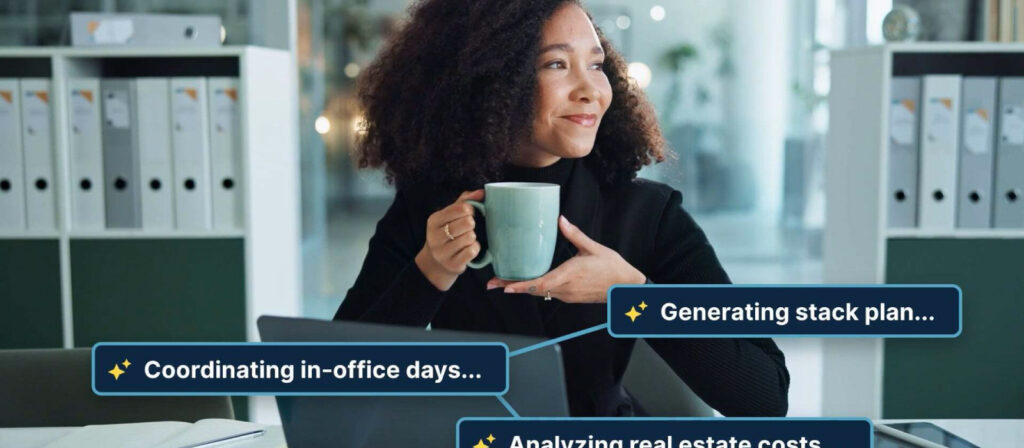The Modern CRE Advisor: Talking Workplace Strategy With an Expert

 What does it take to grow a CRE firm at both the office and broker level? We sat down to talk to Solomon Poretsky, EVP at SVN, who is responsible for delivering training as well as providing strategic planning and consulting for both SVN and its affiliates. Whether it’s helping to optimize compensation systems to motivate, reward and retain independent contractors, or developing cold call strategies to increase conversion rates, Solomon is dedicated to helping everyone at SVN improve their results.
What does it take to grow a CRE firm at both the office and broker level? We sat down to talk to Solomon Poretsky, EVP at SVN, who is responsible for delivering training as well as providing strategic planning and consulting for both SVN and its affiliates. Whether it’s helping to optimize compensation systems to motivate, reward and retain independent contractors, or developing cold call strategies to increase conversion rates, Solomon is dedicated to helping everyone at SVN improve their results.
 What does it take to grow a CRE firm at both the office and broker level? We sat down to talk to Solomon Poretsky, EVP at SVN, who is responsible for delivering training as well as providing strategic planning and consulting for both SVN and its affiliates. Whether it’s helping to optimize compensation systems to motivate, reward and retain independent contractors, or developing cold call strategies to increase conversion rates, Solomon is dedicated to helping everyone at SVN improve their results.
What does it take to grow a CRE firm at both the office and broker level? We sat down to talk to Solomon Poretsky, EVP at SVN, who is responsible for delivering training as well as providing strategic planning and consulting for both SVN and its affiliates. Whether it’s helping to optimize compensation systems to motivate, reward and retain independent contractors, or developing cold call strategies to increase conversion rates, Solomon is dedicated to helping everyone at SVN improve their results.Solomon Poretsky is the Executive Vice President of Organizational Development for SVN. Prior to joining SVN, he was a partner at Custom Skills Development, a commercial real estate consulting firm that provided coaching, development, and training services to agents and commercial real estate brokerages across North America. His commercial real estate career started at Marcus & Millichap, where he was involved in over $1.2 billion of listings, sales and closings as an agent, a regional manager and a recipient of that firm’s prestigious National Faculty Member designation.
Who you are now, depends on where you were then – we asked Solomon to tell us about his background and what led him to focus on organizational development in corporate real estate.
SP: We are going way, way back. I got out of college in 1996 with a liberal arts degree. Back then with a liberal arts degree you had three career choices: to end up at McDonalds saying “do you want fries with that?”, to be a secretary or to go into web design.
I actually first started out as an IT guy and what I figured out from my job where I had to push adoption of technology at a consultancy that I ran was that I really hated doing technology work but I loved selling the technology. Unlike a lot of people now – especially, the millennials and the older quarter of gen X who kind of went to school for real estate and they knew they were going to go into it from an early age – I literally came across a classified ad for a commercial brokerage position in the Saturday print newspaper. I answered the ad because I just wanted to learn how to sell and I got connected with a brokerage firm that had an amazing sales training program and an amazing leader, so I started out selling properties. I did largely Class C office and industrial buildings in the inner suburbs of Sacramento which is about 90 miles northeast of San Francisco. Pretty early on I got chosen to mentor very, very green agents. From my time mentoring I became a manager and I helped manage a large office and then I built an office from scratch in Minneapolis, where I am now based.”
After about six years of building his office from square one and really getting to know the industry, Solomon mastered the art and science of teaching brokering.
SP: You know the best way to learn to broker is to teach. So as someone teaching junior agents from scratch it gave me an opportunity to sharpen my brokerage skills but I also really learned what it takes at a street level to make a commercial brokerage operation tick. After that role, I spent a couple years consulting and then I originally contacted SVN as a consultant to help develop training materials. One thing led to another and I found this position. We were a match for each other. Now it’s been a little over two and a half years and I am still awake before my alarm every morning.
SVN is a commercial real estate organization with 200 offices & 1400 advisors and staff providing sales, leasing and property management across the globe. Solomon tells us how their biggest differentiator from other CRE advising firms is their commitment to maximizing value for clients.
SP: Our real difference is that we are built to be client focused from the ground up. Our mission is to create amazing benefits for our clients, our colleagues and our community. We were the first firm to commit to co-op – 50% of the fee 100% of the time. So if you are a broker and you bring a client to one of our deals you get half the fee. I don’t care what firm you come from. I don’t even care if you are a residential broker that has never done a commercial deal but you have a high net worth private investor that we missed, you are getting half the fee. And we’ve done that because we have an absolute belief that if we expand the database of buyers, we will generate better results for our clients. It’s funny, we came up with this concept about 30 years ago and back then it was pretty fresh and you could argue it was ahead of its time. Now buying pools are so fluid for commercial real estate assets, so you don’t know when the buyer is going to come from out of state, so you’d think that our approach would be obvious and widely copied, but it isn’t.
For example, up here in Minneapolis we have a lot of foreign buyers from Scandinavia and Canada specifically for what are really private capital assets. I mean, like when mom and pop from Thunder Bay own an apartment building on the fringe of downtown Minneapolis. You know the next investor from Thunder Bay, Ontario is not in the database of anyone in Minneapolis – period. So you have to be open to everyone.
And that attitude towards doing business spills over into the way we do leasing, it spills over into the way we do property and facility management for our offices that are in that business line. And we are really focused on the belief that if we are positive members of our community we will service our clients.
Last year Solomon worked with a team of economists and statisticians to test SVN’s value proposition on splitting the fee between two brokers.
SP: We pulled 15,000 sales records out of Real Capital Analytics and we said okay “what’s the average price per square foot for deals sold with one brokerage? What’s the average price per square foot for deals sold with two brokerages?” What we found was that on average when two brokers are involved the selling price is 9.6% more per square foot. I don’t care which two brokers you have involved, it’s that every firm in town does better when they open the deal up and another firm can bring the buyer.
With over a decade of experience in real estate, we asked Solomon to tell us what changes he has observed in the differences in skills needed to be successful as a Modern CRE Advisor:
SP: So many things that were fundamentally true are still fundamentally true. In a lot of ways the business hasn’t changed much from what I learned from my mentor who started doing this about 40 years ago. At the end of the day, good brokers they know their markets cold, they understand what the clients need and they execute on it. Really underlying all the technology in our business is the need to provide basic human skills and have a basic human connection. So what all this technology has done, is it has raised the bar so that you can’t be mediocre and make it long-term.
The broker that has the relationships comes out ahead, but the broker that has the ability to form the relationships and has all the data and all the tools to add more value to that relationships is going to be the broker that truly wins. Clients are demanding more, even though at the core it is really the same thing.

With flexible working on the rise, Solomon shares a few key principles that facilities managers should keep in mind when buying space for virtual, remote and growing teams.
SP: I think the key principle to keep in mind is to stop worrying about principles and rules and start thinking about what the human beings in that space actually need. If you look at the history of office space design, way back when in the 1950s, it was mostly privates with a couple of close by open, low cubes — the Mad Men office model, private with support staff in cubes. Then you had everyone in cubes. Then you had open office models. Then we realized open office models don’t work with anything really – and by open I mean the trading floor model that is great on a trading floor, great in an architecture office, where people need big open spaces to work with big pieces of paper but we realized that doesn’t work for humans. So the real principle to keep in mind is you need to design the space for what the workers in the flexible workplace need, which means what you need to do is you need to take a kitchen sink approach to developing space.
The best space has a little bit of everything; So you have a mix of some hyper-private areas whether it is a private office or a calling booth type space. You’ve got some open areas for people to work open, you’ve got team rooms you’ve got large training areas you’ve got socializing and relaxing areas where people can do work but they can also blow off some steam and they can have an impromptu meeting. You need to build a space that allows for collaboration.
Solomon tells us how that is the buzz word in business today: collaboration, collaboration, collaboration. But collaboration is just one of four types of work.
SP: Gensler has done the research and collaborating is only one of four types of work. When we are at work of course we collaborate and, hopefully we achieve synergy. We learn – that’s the next type of work because we all have to be constantly getting better at what we do. The third type of work, we need to socialize. The interactions we have that are not necessarily tied to formal collaboration are what makes it possible for us to let our guard down, have fierce conversations and embrace blue skies – so water cooler talk is work. Interestingly the last type of work which I think we have lost track of the last 20 to 30 years is focus work.
What is focus work?
SP: Focus work is work that’s done centrally alone that requires a lot of attention. Whether it is a graphic designer trying to get into the nitty gritty of getting the characters kerned right, or a programmer editing code or a sales person picking up a phone to prospect and talking to someone and really listening to what they are saying.
To come full circle, we all talk about collaboration but the research shows that on average 55 percent of working time is spent doing focus work. So when you are building flexible workspaces you need to go out and create a space that is conducive to people coming in and focusing. And I realize the idea behind flexible work is that we all focus from home and then we come into the office for meetings. In my experience, that just isn’t the case. A lot of people can’t focus at home so they come into the office to focus because they need that change of pace. So as you are designing flexible workspaces you need to design for focus.
We asked Solomon what he foresaw as being the biggest influence to change the future of real estate and how he suggests we prepare for this change.
SP: The number one change we are going to see is we need less space to do the same work. I assure you there are a bunch of companies that are still building out 35 square foot cubes and 130 to 140 square foot offices. Those designs are based on the assumption that you have a large number of paper files, a tower computer, and a CRT monitor – and if you don’t know what a CRT monitor is, take a flat screen and put a mid-sized shipping box behind it. Just those changes alone, allow you to shed 20 to 30 percent of the space in a private workspace simply because you don’t need physical space for big boxes and big file cabinets. That’s a change.
Again, people who have gone flexible have realized this, but a lot of people still aren’t flexible yet. Space is going to stop being assigned on rank and it is going to need to be designed based on need.

To explain this shift to flexible office space, Solomon gave the perfect example – himself.
SP: Perfect example, I am an EVP for what is really a global company. Anywhere in the world 30 years ago I would have a big corner office, right? I’d have a 13 by 26 office. It would have a great gigantic, L-shaped desk with a credenza, I’d have a nice eating table and I’d have a bunch of mahogany – that’s what most companies do for their EVP historically. Well, here’s the thing, I am on the road 30 to 40 weeks a year. What a waste of space! I don’t need an office. What I need is a really good computer.
I think I am a good example of this, I work from home, but when I am at headquarters our flexible workspace has a desk that’s actually a hot desk and I share it with an intern because I am only there a few weeks a year. Again, rank would dictate space but that intern is in the office more than I am so she needs that space more than I do. So that’s really the future of space.
We asked Solomon to share with us the best part of his current role.
SP: There are two parts to the best part of what I do. I really enjoy sitting down with Excel and trying to find ways to quantify what’s going on with our business, build forecasts and, basically, I love numbers. To me, Excel is a video game. That’s one of my passions. I lose track of time doing it.
The most rewarding thing I do is when I can get into an office and sit down and talk with advisors – which is what we call brokers – and sit down and talk with the person who runs that office to help them figure out what’s going on and help them get even better at what they are doing. I love the human contact and the ability to help people.
Have more questions about CRE advising? Feel free to get in touch with Solomon via LinkedIn or shoot him an email at [email protected].
Has your office gone flexible? What advice do you have for managing space for the different needs of your employees?
Photos: Maxime Staudenmann, Alejandro Escamilla, Tobias Zils




